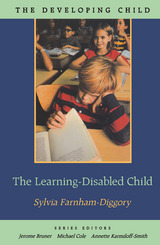

Who is the learning-disabled child? As theories multiply and research accumulates, this pressing question persists, leaving parents and educators and, particularly, students at a loss. The Learning-Disabled Child does much toward providing an answer. A broad-based account of what is currently known and done about learning disabilities, the book gets at the roots of this perplexing problem—in the law, in the school system, and in the child—and offers a new outlook for its treatment.
Since the 1970s, millions of children have been misclassified by public schools as learning-disabled, while many others with true learning disabilities go unidentified and unhelped, as case material presented here makes poignantly clear. Over the same period, research on the nature of learning disabilities, based on samples of misclassified children, has yielded a cloudy and confusing picture. Drawing on her own background in cognitive, developmental, and abnormal psychology, as well as her research into reading and dyslexia, Sylvia Farnham-Diggory cuts through the confusion surrounding learning disabilities. She describes advanced research and clinical data that elucidate handicaps in reading, writing, spelling, drawing, calculation, remembering, and problem-solving. In addition, she outlines a straightforward assessment procedure that would reduce the misclassification of learning-disabled children and, if adopted by schools and private diagnostic services, would save the nation billions of misspent dollars.
Prescriptive as well as descriptive, The Learning-Disabled Child offers invaluable advice to parents seeking the best methods of diagnostic evaluation, and to teachers in search of the most effective means of helping these children. Far-reaching in its scope and firmly practical in its orientation, the book will prove instrumental in the identification, understanding, and treatment of learning disabilities.

How should we educate the children of tomorrow to solve the problems of today?
A new educational model is generating widespread interest and excitement among educators, parents, and community leaders. Known as "cognitive apprenticeship", the model draws upon contemporary cognitive and developmental science and specifies techniques for capitalizing on children's inborn ability to learn in complex natural settings. Sylvia Farnham-Diggory reports on a wide range of school programs that illustrate this innovative approach to schooling.
The new approach contrasts sharply with much current school practice, which is based on early twentieth-century theories of learning. These early theories, in misguided attempts to be "scientific", defined the acquisition of knowledge in terms of simple, quantifiable test behaviors. School practice derived from such outdated theory continues to revolve around fragmented lessons that can be easily counted and graded.
New research in cognition and human development shows that the acquisition of knowledge must be defined in terms of complex interactive networks. It cannot be acquired from workbooks or ditto sheets, nor can it be assessed through paper-and-pencil tests. Mastery of basic skills, a delight in history, literature, and science, and a creative approach to problem solving are best encouraged when children have opportunities to work alongside experts in meaningful and important contexts, thus participating in cognitive apprenticeships.
While never losing sight of her theoretical framework, Farnham-Diggory offers many practical suggestions for transforming classrooms into places of genuine intellectual growth. Schooling sets out a creative and realistic agenda for parents, teachers, school administrators, business leaders, and other concerned citizens who are looking for ways to replace traditional 1930s-style classrooms with rigorous and exciting educational environments.
READERS
Browse our collection.
PUBLISHERS
See BiblioVault's publisher services.
STUDENT SERVICES
Files for college accessibility offices.
UChicago Accessibility Resources
home | accessibility | search | about | contact us
BiblioVault ® 2001 - 2024
The University of Chicago Press









